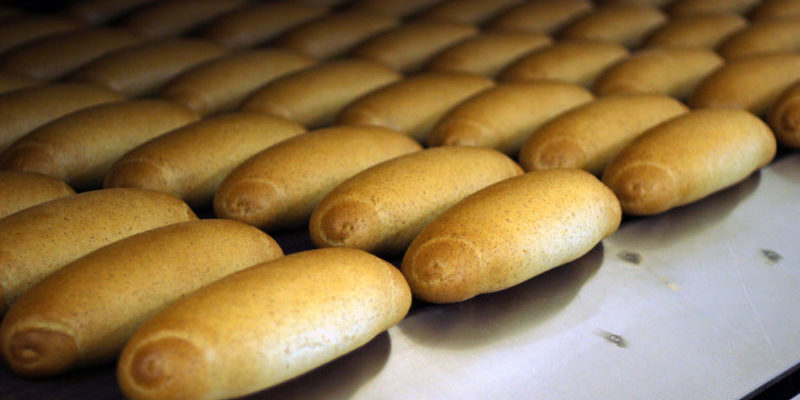Understanding Industrial Automation Controllers: Revolutionizing Bakery Operations
Automation has an increased presence in industrial baking. Ingredient handling, pallets, warehousing, and packaging are all being automated. More bakeries are also turning to automating their warehouses to organize items and maximize the shelf life of their products, minimize damages, and resolve capacity issues.
But what goes into these automation controllers and how do they work? It’s time to make sense of industrial automation controller options for bakeries. Let’s begin.
Choosing a PLC, PAC, or IPC
Depending on your bakery, automation can either provide individual control over a single machine or a comprehensive solution for the entire facility. Based off your needs, one controller type may be better for your bakery than others. Programmable Logic Controllers (PLCs), Programmable Automation Controllers (PACs), and Industrial Personal Computers (IPCs) are all capable of automating a station, machine, or the entire floor of machinery. For a modular approach in which the system is broken down into logical pieces or functions, you can utilize smaller PLCs.
The challenge here is deciding whether you wish to run a whole program on a single PLC or separate everything into subsystems that operate between smaller or micro PLCs. Since a single programming environment inevitably saves money and time (because PLCs can be converted), most bakeries choose this route.
However, PLC, PAC, and IPC controllers all have a place in industrial baking. To decide which option is best, consider the following factors:
- New and existing automation systems in your bakery
- Analog devices
- Loop controls
- Environmental concerns
- Discrete devices
- Specialty features or modules
- Programming
- Communication
- Local and remote I/O locations
For example, if you already have an automated system in place, the best practice is to select a controller that is compatible with the existing system. Unfortunately, there are some controllers—even those developed by the same manufacturer—that are incompatible with others.
Define the I/O Count Devices
When you are considering automating your bakery, it is good practice to make a list of all the I/O devices in your facility. List the analog sensors, digital sensors, control valves, actuators, and so in. Include information about power requirements, signals, and communications.
The number of I/O points within your bakery help determine which automation controller is best. Bakeries commonly make the mistake of implementing controller systems that are ideal for their current production but leave no room for growth. It is recommended that you allow for an extra 20% I/O to avoid any difficulties with future expansion.
You also want to consider any specialty equipment in your bakery, including high-speed output, high-speed counting, real-time clocks, and so on. Some machines with specialty functions may be unsupported by controllers.
Communication
Figuring out how the entire system is going to communicate is a step that must be completed early on. There are some controllers that have a single or double port for programming purposes, while others may be able to connect to multiple PLCs and devices within the plant.
Before choosing an automation controller, look at other devices used for communication, such as industrial Ethernet and human-machine interfaces (HMIs). Outline the Ethernet protocols, such as Modbus TCP, Ethernet/IP, or any others present. The controller you choose should be able to support the communication type now and in the future.
Required Hardware & Software
Your automated controller system should have enough memory to meet the requirements of various programs and data flow. The number of devices supported by the controller will also affect how well it processes the data. Similarly, if your bakery has machines with multiple sequences and sophisticated control functions, such as mixing and making a variety of dough, or has multiple recipes stored, this calls for an increased level of memory and processing power.
Aside from the hardware requirements for your automation controller, there should also be a proper amount of software available. The more advanced the controller, the more expertly written software becomes necessary. Do not choose a controller that does not have a decent amount of literature detailing its abilities, as well. If an automation engineering company offers training for their control systems, that will benefit you and your bakery in the long run.
Should I Choose a PLC, PAC, or IPC For My Bakery?
In the end, the automation controller system that you choose for your bakery is the one that increases productivity and efficiency. Most of the time, bakeries end up selecting between PLCs and PACs. Though these systems are similar, there are some differences to consider, such as multiple processor modules in a single rack, multitasking abilities, programming languages, tag-based addressing, distributed control system (functionality), standard PC-networking, and motion control. PACs are more flexible than PLCs since they use Ethernet networking. However, PLCs are becoming increasingly similar to PACs.
PACs are optimal if you want to standardize a single I/O type and processor, since PACs are designed to handle many applications. PLCs work better with standalone machines and appliances. If you are unsure of which controller is right for your bakery, call an automation engineering company for a consultation.
Looking For Trusted Industrial Automation Companies Near Me?
Although there are many automation controller options out there, you want only the best for your bakery. Consider the processes that go on within your company and what you are aiming to improve. Depending on the technology present, as well as the environment, you may need either a PLC or PAC.
Have questions about automation controller systems for your bakery? EZSoft has solutions for you. Since 1999, EZSoft has been assisting multiple industries, including Food and Beverage, with automating their facilities. If you want increased productivity and efficiency, then it is time to give EZSoft a call at (484) 568-5040.







